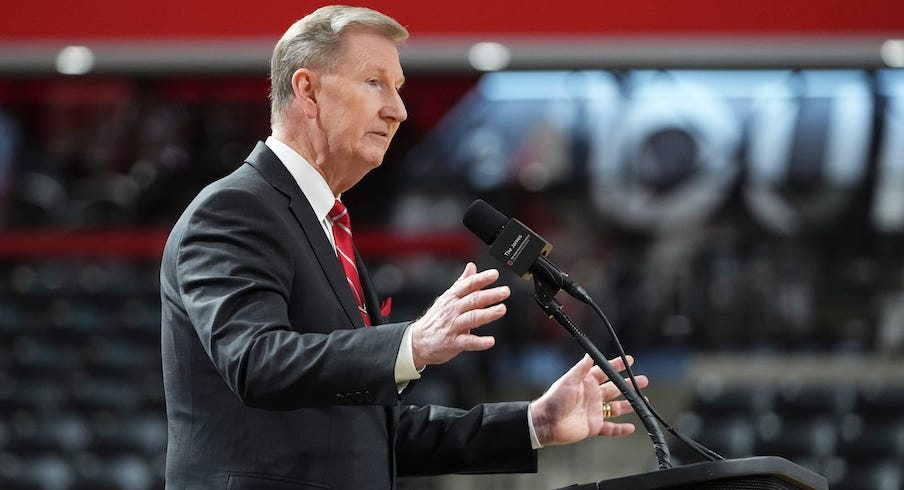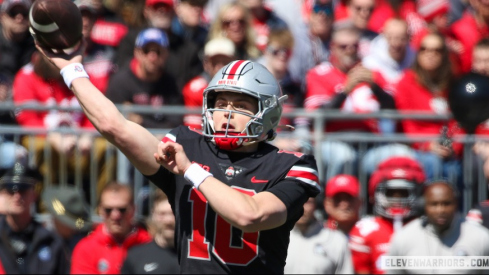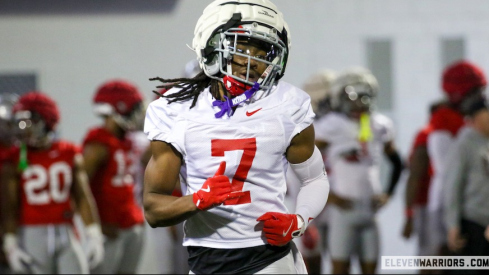Even though Ohio State athletics is reporting a $10 million deficit for the 2024 fiscal year and its expenses are about to increase even more in 2025, Ted Carter is confident Ohio State’s athletic department will remain profitable without cutting any sports.
Ohio State’s new president says the deficit for the fiscal year that just ended shouldn’t be seen as a reason to worry. Echoing what new Ohio State athletic director Ross Bjork told the Columbus Dispatch last month when he revealed that OSU would report a budget shortfall of more than $10 million for the year, which started in July 2023 and ended in June 2024, Carter said that deficit was largely a result of Ohio State hosting only six home football games in 2023. He expects Ohio State to make up that revenue by hosting eight home football games in 2024.
“Actually that's not that bad of a deficit, considering that on many years we have eight home football games,” Carter told Eleven Warriors in an interview for this week’s Real Pod Wednesdays. “So I have no doubt we'll be able to recover that.”
That said, Ohio State is beginning to brace for a new category of expense that will hit athletic departments across the country next year when schools begin sharing revenue with their athletes for the first time. Bjork told the Dispatch that Ohio State will share the maximum amount of revenue it is permitted to share with its athletes, a number that’s projected to start at approximately $22 million and increase each year.
Given that many college athletic departments already spend more than they make each year, it will only become more difficult for most athletic departments across the country to be self-sufficient in the new era of college sports. But while most athletic departments will likely need subsidies from their universities in order to cover the costs, Carter is confident Ohio State athletics will come up with the revenue to cover the added costs on its own.
“We've just got to make sure that we maintain, even with this revenue share model, that we can do everything that we can to be self-sufficient,” Carter said. “This program has been self-sufficient, and we anticipate it will be self-sufficient going forward. And I would argue if you look across the entire landscape of college football, you're going to find only maybe three to five programs that are going to be able to say that in the next model.”
One question that has lingered with revenue sharing on the horizon is whether Ohio State and other athletic departments will need to reduce the number of sports they sponsor in order to decrease costs. Carter is adamant, however, that Ohio State plans to keep all of its nation-leading 36 varsity sports teams.
“We made one big, bold statement, and that is we're going to maintain 36 Division I sports,” said Carter, who was the president at Nebraska before becoming Ohio State’s president in January. “I watched during COVID-19 what schools like William & Mary and Stanford (which also has 36 sports but opted to cut 11 sports in 2020 before reinstating them in 2021) went through. Even in the state of Nebraska, which happened before I got there, the University of Nebraska at Omaha cut football and wrestling at the Division II level to move into the Summit League. Heavily criticized at the time.
“And as I've watched the college landscape and think about what it means to maintain these sports, it's important once you get them to do everything you can to hold on to them. You don't want to lose that. It's too important to the student-athlete. So we've made a declarative statement that we're going to hold on to that.”
That doesn‘t necessarily mean Ohio State will continue to invest as many resources into all of those sports as it currently does. Former athletic director Gene Smith told Eleven Warriors in June that Ohio State had already had conversations with coaches from several sports about cutting expenses and that it is unlikely Ohio State will be able to continue giving all 36 sports as much funding as it does now.
Carter said Ohio State will prioritize the sports that generate revenue for the athletic department – namely football and men’s basketball, though Carter believes women’s basketball can also be a revenue-generator.
“There's going to be change, and we're going to have to be reactive,” Carter said. “We're going to have to be thinking ahead. We're going to have to be strategic in order just to be able to maintain our 36 Division I programs, and yet still continue to be able to compete and win in our football program.”
“We've just got to make sure that we maintain, even with this revenue share model, that we can do everything that we can to be self-sufficient.”– Ted Carter on the importance of keeping OSU athletics profitable
Carter, who was a varsity hockey player at Navy, says he is a supporter of the move to a revenue-sharing model in college sports. He thinks it can allow the NCAA to move away from the “wild, wild West” environment – as Smith often called it – that has been pervasive over the past few years with players getting paid for their names, images and likenesses, but only if college sports leaders work together to create enforceable rules around it.
“It won't fix itself,” Carter said. “It sets up a situation where we can actually put some more rules and guardrails around NIL. Reduce the third-party collectives, bring it inside, control it. But then more importantly, for senior administration, whether it be at the conference or even at the NCAA level, it's got to be monitored and there's got to be rules put in place. Otherwise, we'll still be the wild, wild West.”
Carter also believes it is important for college athletes to remain students rather than employees.
“Does revenue share mean that college athletes are now professionals? Does it mean that they're employees of the university? I would argue that we need to do everything we can at the NCAA level and our members of Congress that may be writing laws to help define what student-athletes are going to be,” Carter said. “We've got to maintain the student-athlete part. What has to be the attraction for somebody to come and wear a jersey for Ohio State still has to be to get a degree here.
“And we've been really, really successful at that. I've enjoyed that at every academic institution I've been. Division I athletes graduate at a higher rate than anybody else. We have the same thing here. … Those are things that we should be proud of, and we should make sure that we don't lose that. So I'm a big supporter of making sure that as we go through this revenue share model that we don't lose the concept of the student-athlete.”


